In an ideal world, a mild autumn and winter are followed by a warm, dry spring and the prognosis for the coming season is good. Sea temperatures quickly achieve critical values, the food chain is rapidly established and our migratory species are soon enticed to shore. The season is off to an early start and prolific sport possible from mid-April. 2012 began on an ideal note, with a very mild autumn leading to an equally benign winter. Expectations for the new season were high. The early spring period was fine and warm and by late March inshore water temperatures had reached 11c, sufficient to commence formation of the food chain. However, the weather gods proved to be in mischevious mood and a change to much cooler and abnormally wet weather throughout April and into May caused sea temperatures to stabilize, effectively arresting development of the newly emerging food chain. The migratory species remained off-shore, seemingly aware that there was no sign of improvement on the horizon. Similarly, frustrated fly fishers waited patiently for the change in climatic conditions which would lift sea temperatures and belatedly kick start the season.
In retrospect, the normally favoured south coast has fallen victim to the vagaries of the weather in recent years, experiencing a clutch of cold winters which delivered heavy snowfall and the lowest temperatures for several decades. Summers have been cool, wet and often extremely windy, rendering the BBQ practically redundant. The impact of these conditions has seen a distinct down turn in the quality of sport to be enjoyed in recent seasons. Perhaps a trend towards less predictable weather patterns and cooler temperatures is developing and ‘Global Warming’ will be recognized as one of the more elaborate urban myths.
May 2012 – Early May provided air temperatures more akin to January than spring and with the newly appointed ‘Minister for Drought’ settling into office, the heavens opened……and forgot to close. On the 5th of May, an exploratory visit to a shallow, sheltered mark produced my first fish of the season, a diminutive bass which fell to a red tagged Diawl bach. The air temperature was 5c! Fishing remained very much in the doldrums as May progressed, with a complete absence of both bass and mullet from inshore marks until finally our prayers were answered and a heat wave wheeled in from the near continent. The final week of May saw air temperatures reach 27c and sea values rise by an impressive 6 degrees centigrade. On the evening of May 24th I visited a south coast estuary to see if this sudden rise in temperature had brought the shoals to shore. I was shocked to witness the force with which the river ran in to the sea. Weeks of torrential rain had created a back log of cold, dirty water which still drained from fields and meadows along the river’s course (and would continue to do so for months to come).
Estuary mouths are wonderfully rich environments and normally hold good populations of bass and mullet, which return annually to capitalize on the abundance of food available. The incredibly high volume of water emanating from many south coast rivers during 2012 appeared to upset the eco-system, with the effect that rather than taking up residence, the shoals chose to steadfastly avoid the estuaries. The mullet shoals then fell into two distinct groups, those which migrated straight up river for the entire season and those who remained off-shore in deep water, only venturing in to the shallows during periods of warm and settled weather.
On the evening of the 24th, the estuary was devoid of fish. The surrounding flats were a different proposition however, with literally thousands of fish cavorting in the evening sun. Dave Ball opened his account for the season with a fine 4lb thick lipped mullet, just as darkness fell.
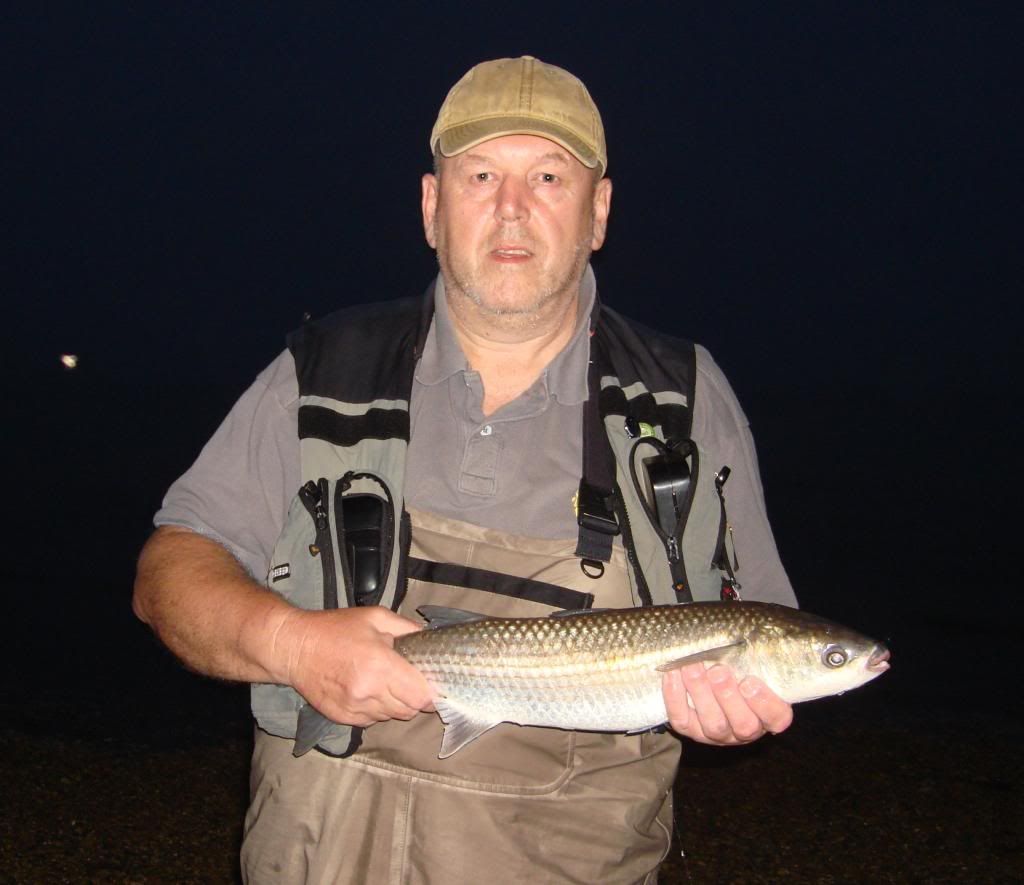
June 2012 – May’s heat wave proved to be short lived. The weather reverted to a pattern of strong northerly winds and periods of intense rainfall. The estuaries ran even higher and the open coast in general was reduced to a brown, churning mass. Any brief window of respite from the unseasonable storms had to be grabbed instantly.
The afternoon of the 4th was spent in the company of ‘Choccy’ and his brother Ivan, who had travelled over from Sydney for a short holiday. We were keen to introduce Ivan to the delights of Solent bass and mullet on the fly but conditions dictated that not a single fish was observed during the entire session. Despite the lack of fish, the usual Malby brothers banter provided a highly enjoyable few hours.
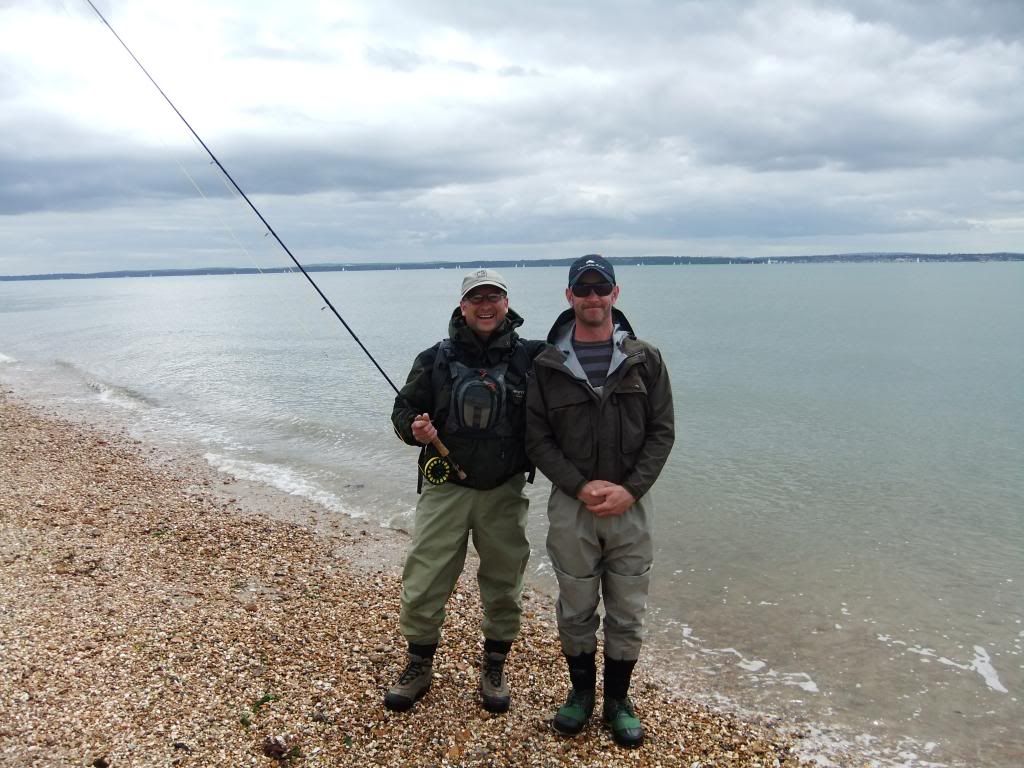
On the evening of June 19th, following two days of reasonably light winds, I visited a local mullet mark in search of some sport. But not a single fish revealed itself as the tide slowly reclaimed the shore and I was forced to fish blind over known lies. Perseverance paid off when the line eventually sprang to life in my hand. The fish instantly broke free but the very next cast met with resistance once more and twelve minutes later a sparkling 3lb thick lipped mullet posed for the camera. At last the season was underway!

Ten days beckoned on the Costa Blanca from the 25th of June and I was very much looking forward to pitting my wits against the huge Pardette (flat head mullet) which inhabit Spain’s shores. What a joy to wet- wade in trunks and a pair of crocs in blissfully warm water and beneath scorching sun shine, following the abysmal summer in the UK! The prime fishing period is from daybreak at 6am until 9am, when the strengthening sun pushes the shoals of bass and mullet from the shallows in to deeper water. The array of species available to the fly angler in the Med is incredible, ranging from bonito, bluefish and barracuda to snappers, skipjack tuna and Spanish mackerel. However, it is the amazingly powerful Pardette mullet which have captured my imagination.
Each morning provided scintillating sport with hoards of feisty thin lipped mullet and bass in the one to two pound range.
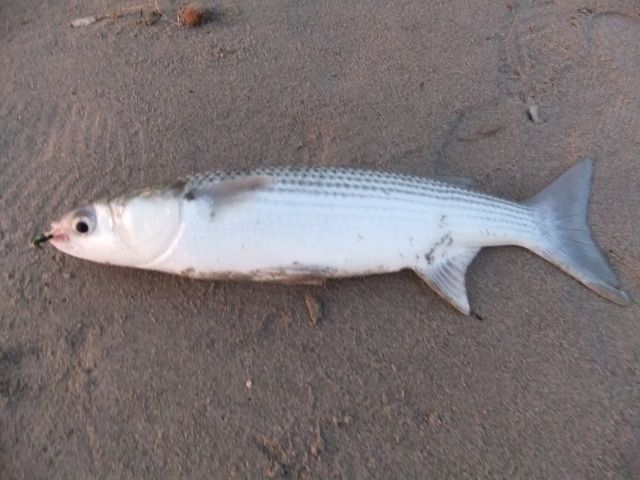
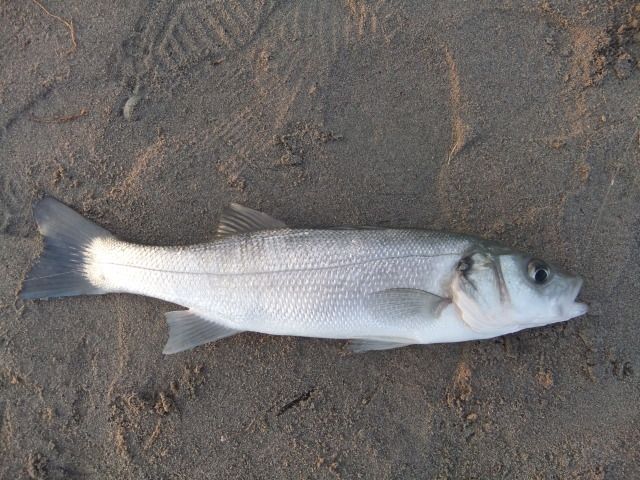
But the highlight of the trip came on the morning of the 27th, when an 11lb 2oz Pardette fell for a size 12 flexi-shrimp. A tremendous forty minute battle followed before the fish was finally beached.
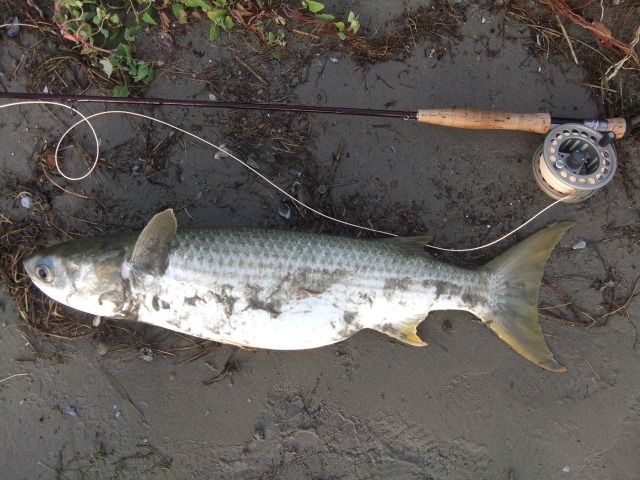
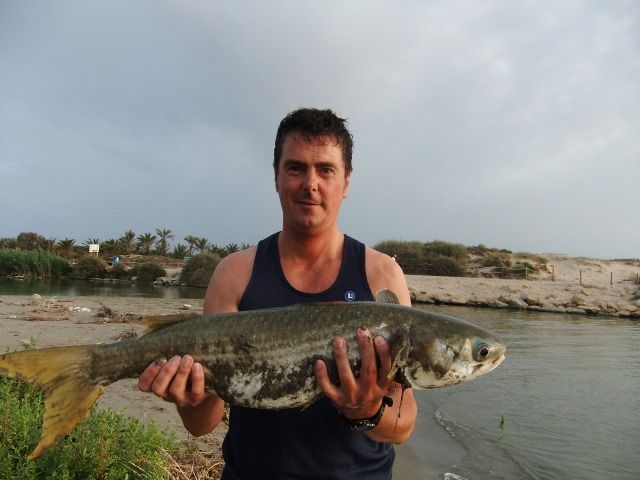
July 2012 – Back in the UK, July continued with the wild, wet and windy theme, with the result that the shoals remained tantalizingly off-shore. The season was developing into a stop-start affair….short lived spells of warm, settled weather would bring fish in to feed in the shallows for a few tides before stormy conditions returned to drive the fish away to deeper water. A heat wave was desperately required and the BBC weatherman duly delivered promise of such an event on the evening of July 19th. I met up with ‘Polite’ the following evening, keen to capitalize on the supposedly improving conditions. Dark brooding skies, soon to unleash rain of biblical proportions and a keen 20mph southerly greeted our arrival. Undeterred, we ventured out onto the flats, forced to fish blind by the developing maelstrom. Eventually conditions improved and some late evening sunshine brought the mullet on. Rusty reactions led to several missed takes before I finally tightened into a feisty 3lb thick lip and the discomfort of wind and rain became a distant memory.
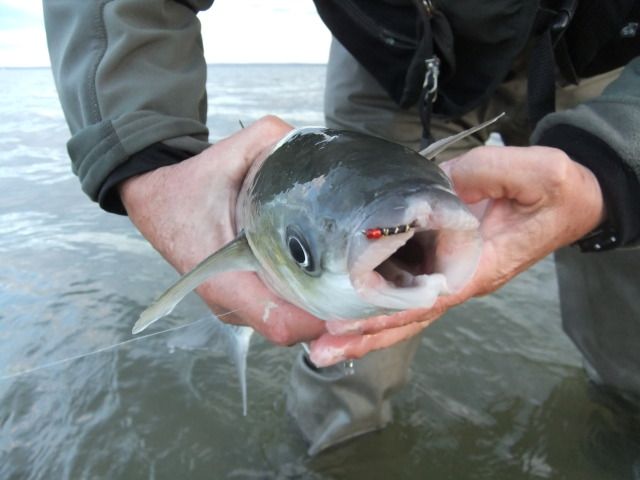
July 22nd – The evening was clear and warm as I returned to the same mark. A number of feeding fish were evident, foraging amongst the waves which broke on a small gravel bar. The fish were quick to take a sparsely tied red necked Diawl bach but equally quick to throw the hook. As darkness fell, the fly was taken with force and seven minutes later a perfectly formed thick lipped mullet of merely a pound emerged from the dark waters, the smallest thick I have encountered.
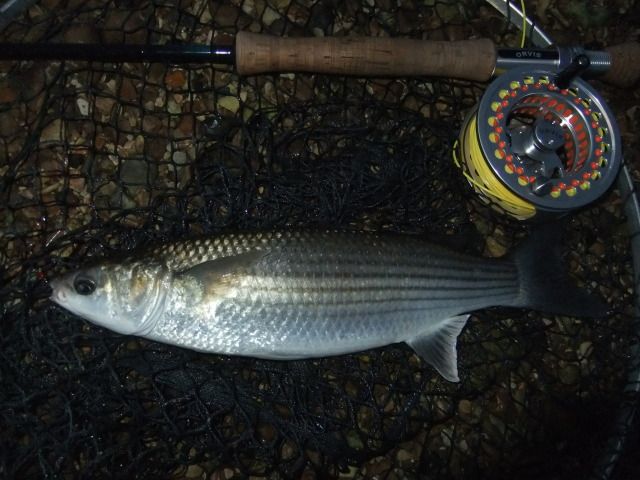
Temperatures by the 24th were into the eighties and I was joined by Tailing Loop for a balmy evening session in search of mullet. A shoal materialized as the sun set to a watery grave and an extremely athletic thick lipped mullet of 2.5lb chose a sparse diawl bach for supper.
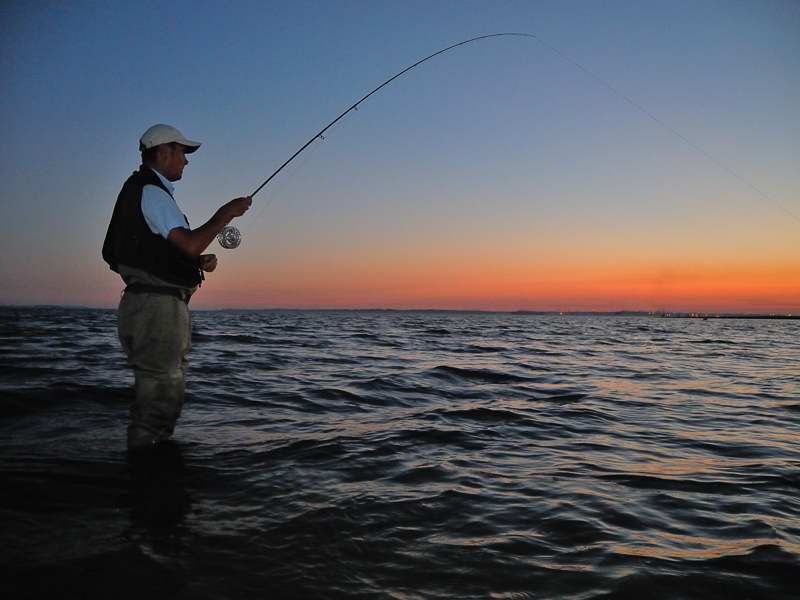
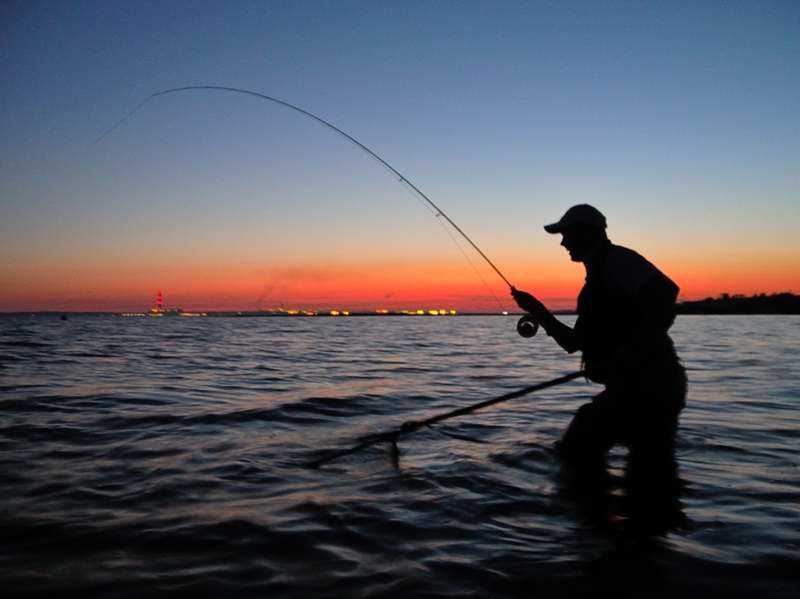
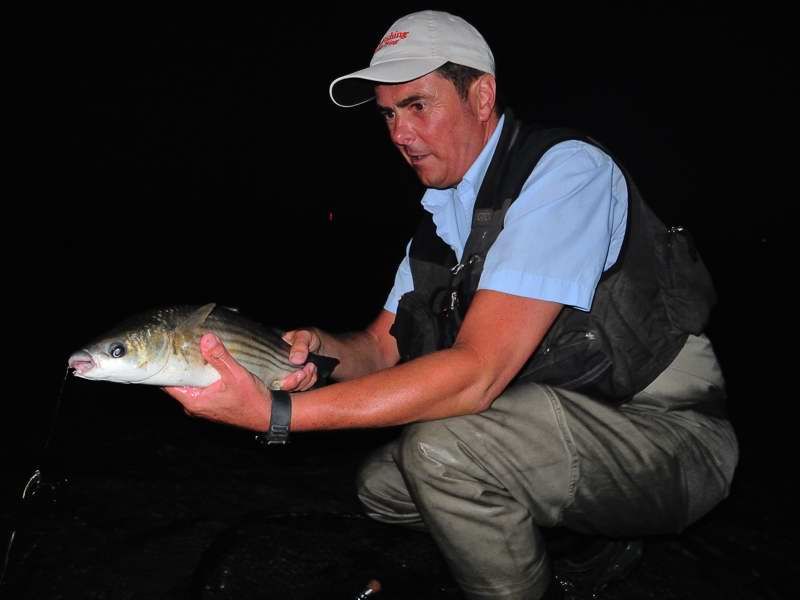
July 28th – With the heat wave rapidly coming to an end and cool, wet and windy weather forecast for several weeks, I squeezed in a couple of lunch time hours at a local mark. Water temperatures would now be at their peak and feeding activity would hopefully match. Strong sunshine greeted my arrival on the flats and the crystal waters appeared bereft of fish. Presently, a large patch of cloud drifted over head and almost instantly grey shapes emerged from a channel to take up position in the shallows. First drift of the flies and the line tightened with surprising force. A powerful fish streaked across the flats and gave an excellent account of its self before slipping into the net fifteen minutes later. The sparse Diawl bach had claimed its fifth fish in six sessions.
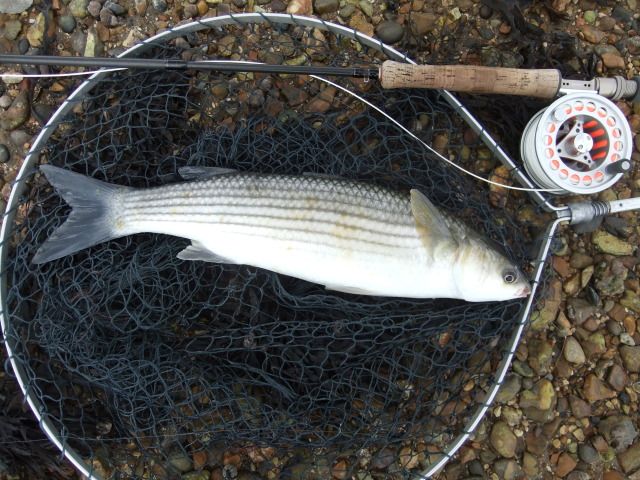
August 2012 - August’s second half showed improvement with rising temperatures and the weatherman promised a belated semblance of summer. A week long holiday from Saturday the 18th allowed me to take full advantage. With bass virtually absent from the open coast, as well as the normally prolific Langstone and Chichester Harbours, I maintained my focus on the transitory mullet population. And so began a period of confusion! Proceedings kicked off at 5.20am on the Saturday in the company of Kent angler Neville Broad, with perfectly calm conditions and a sea of glass. Eventually, the actions of a small shoal were spied as tails and fins danced in unison to the beat of crashing waves. The team of nymphs winged their way to gate crash the party and instantly grabbed a partner. The fly was hit with aggression, suggesting a bass rather than the assumed mullet, and so it proved a few moments later as a chunky bass tumbled into the net. Bass and mullet often feed side by side in shallow water and bass are normally first to the fly.
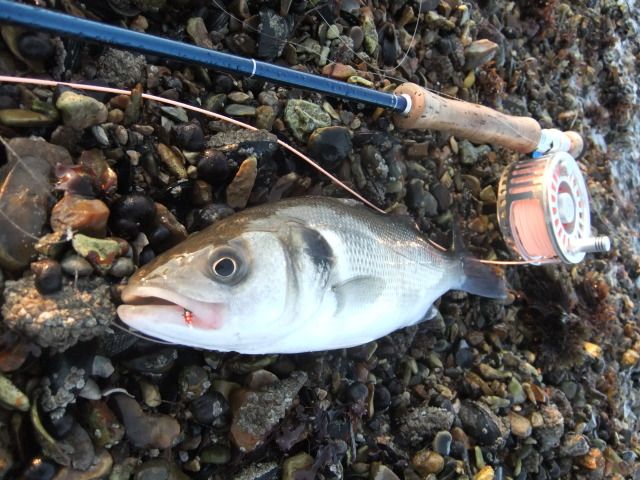
The hunt for mullet was temporarily abandoned at 7.30am, upon observing a developing scene of mayhem, 200m distant. What started as a handful of terns had now graduated to a scene from Hitchcocks 'The Birds'. The surface of the sea literally 'popped' as thousands of bass hammered into fry. Too lazy to change nymphs for a Clouser, Diawl bachs and blood worms were sent to cover rising fish and both patterns were enthusiastically received by fish ranging from 1/4lb to comfortably over the pound mark. After 40 minutes, a brief lull in the carnage afforded time to exchange the point fly for a yellow/chartreuse sparse DNA clouser. Within minutes the sea erupted once more and the clousers went to work. The proportion of larger fish increased and with them, the intensity of sport. At 10am, following more than two hours of hectic action, the blitz subsided.
At 5am the following morning, the mullet quest resumed in a shroud of sea fog.
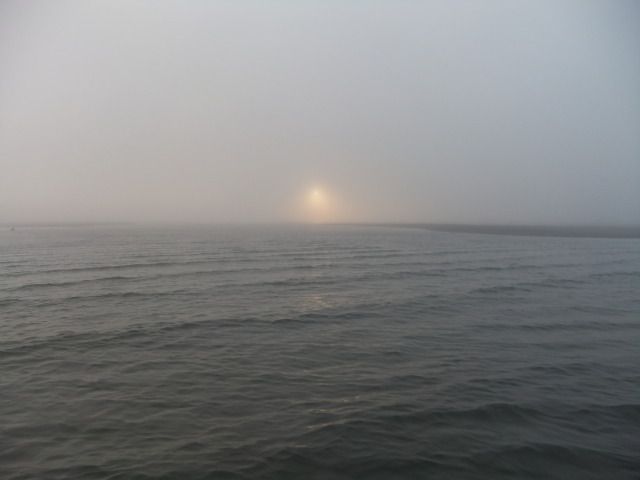
A bass of similar size to yesterday’s capture fell for an Idotea pattern just as ‘Polite’, ‘Portcullis’ and ‘Toml’ emerged ghost like from the mist. Four rods, armed with the most deadly nymphs known to mankind, now went in pursuit of the elusive mullet. Tom was especially keen to land his first thick-lip and with a whoop of delight, his rod bent into the weight of a decent fish. Joy turned to partial dismay however, as the assailant turned out to be another case of mistaken identity.
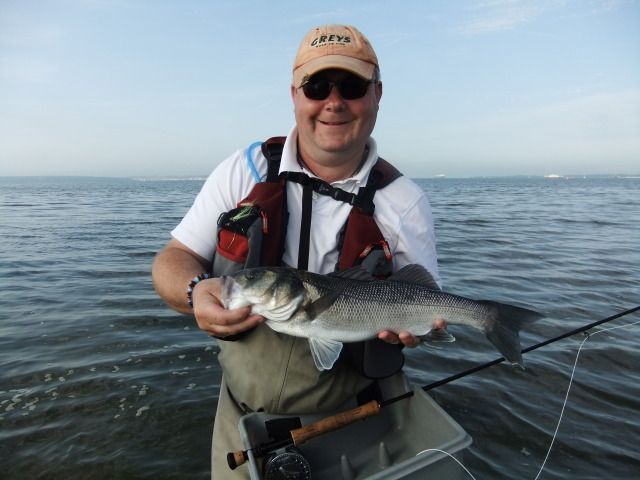
The flooding tide began as a tame affair on the evening of the 20th but came to life as the sun sank into the western approaches. A small group of fish moved through the shallows with purpose, occasionally fragmenting as members peeled off to grab supper. A reverse cast delivered a pair of Diawl bachs with a flexi-shrimp on the point within feet of the shoal. The water bulged as a fish rushed to claim a fly. The high speed run screamed mullet but to my surprise, the assailant turned out to be a 3lb bass, the first of four peas from a pod.

Tuesday the 21st dawned humid and still and for the first time this season my arrival at an estuary was greeted by the magnificent spectacle of a large shoal of frantically feeding mullet. An Idotea pattern on the point was immediately accepted by a fish of around 5lb, which ran full speed into a bed of kelp and liberation. The Idotea was not to be denied however and the very next cast finally produced the first thick lipped mullet of the week.
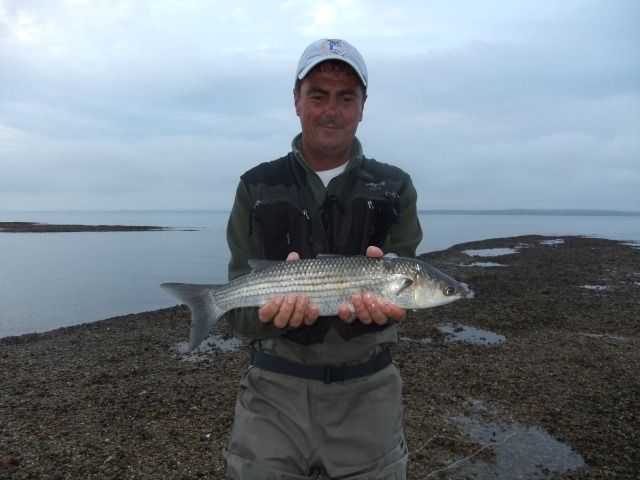
The heat and humidity of recent days was replaced by a stiff, cool westerly breeze on the morning of Wednesday the 22nd. The rising wind pushed white horses through the shallows, muddying the waters and putting the mullet down. ‘Polite’ arrived at today’s mark at 7.30am, just as I spied the first fish of the day. I covered the spreading rings with a sprinkling of Diawl bachs and felt the line jump to life. The first, mullet-like run took me well into the backing but following a short battle it turned out that a bass had once more flattered to deceive.
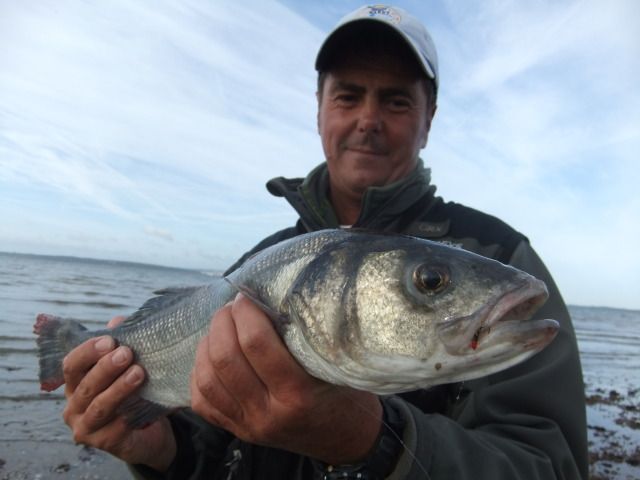
Attentions on the 24th turned to a new mark with a reputation for golden grey mullet. A fine fish of around 2lb was lost before the Idotea claimed a spritely bass and the second thick lip of the week. Dark storm clouds gathered with pace and the first heavy spats of rain fell from the leaden sky. For now, the fishing was over
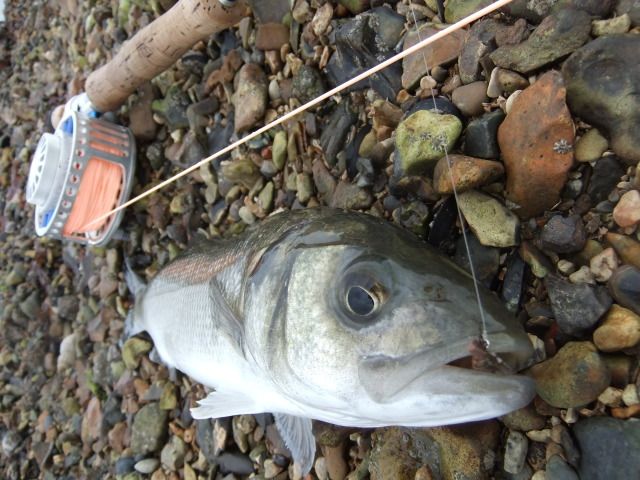
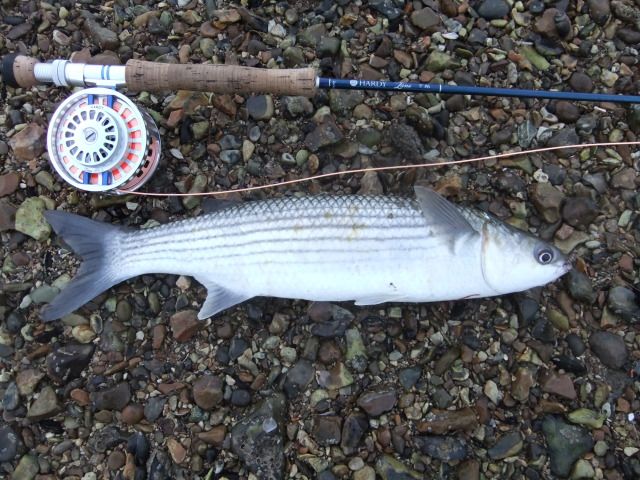
September 2012 – The first week of September brought a return to warm, settled conditions and saw fish returning to the shallows to feed. A visit to the new mark on the 1st produced a sparkling silver bass, which fell for the Idotea.
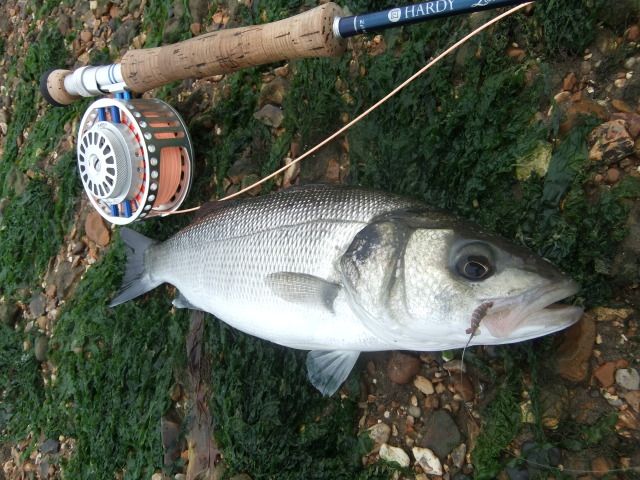
A gloriously warm and sunny evening on the 7th saw a return to the same spot. The hoped for Golden Grey mullet were not around but a solitary fish feeding tight to the sandy shore amongst the lazy waves caught my attention. A large tail fluttered and glowed in the setting sun and I was instantly transported back to Cuba and my one, dismal attempt at a tailing permit. Individual mullet are thought to be no easier to catch than their Caribbean cousins but on this occasion my luck was in! The first, lightning fast run took me far into the backing, as a fish in peak condition powered through the shallows towards deep water. Twenty wonderful and absorbing minutes were required to control the fish and bring it to the net. The mullet was my largest of the season so far and certainly my most prized capture. With one flick of its huge tail, the fish melted into the twilight.

September the 14th heralded a rapid deterioration in weather conditions and once more the shallows became devoid of fish. Mullet numbers typically decline during September, a fact compounded this year by the unusually low numbers of fish to begin with. Compensation comes in the form of larger than average mullet willing to take the fly, when conditions allow. Conditions appeared completely hopeless on the 29th but the lesson I learned that day is never give up! I was ready to do exactly that at 4.30pm in the afternoon. The sea was the colour of Earl Grey and saturated with horrible, stringy red weed. I took one last look at the water before leaving, convinced that this season was all but over. But there they were! An open group of fish cruising into the shallow waters of a small, sandy bay. The first three casts resulted in chases and nips and missed strikes. The 4th cast saw the line tighten and an irate thick lipped mullet go ballistic in the knee deep water. A full 30 minutes were required before the mullet surrendered to the net.

October 2012 – Water quality and weather deteriorated further into October. Fishing opportunities were now few and far between and the fly fisher forced to rely on the constraints of suitable tide, settled weather and free time to coincide in order to present viable fishing opportunity. October has a habit of producing PB fish and this was my incentive for venturing forth on the afternoon of the 13th. I arrived at the water’s edge one hour before low tide to be greeted by the depressing sight of chocolate brown water, laced with masses of red, stringy weed liberated by days of rough seas. Hope seemed forlorn until a bright silver fish leapt high from the tail of a rip. A twenty yard cast delivered the flies into the path of the advancing fish, which took no hesitation in hammering the Idotea. The fish showed incredible turns of speed as it fought tooth and nail to escape the hook during 15 minutes of intense battle. Once on dry land, I was pleasantly surprised to discover that a thin lipped mullet had taken the fly and at a touch over 4lb in weight, maintained October’s reputation for PB fish.
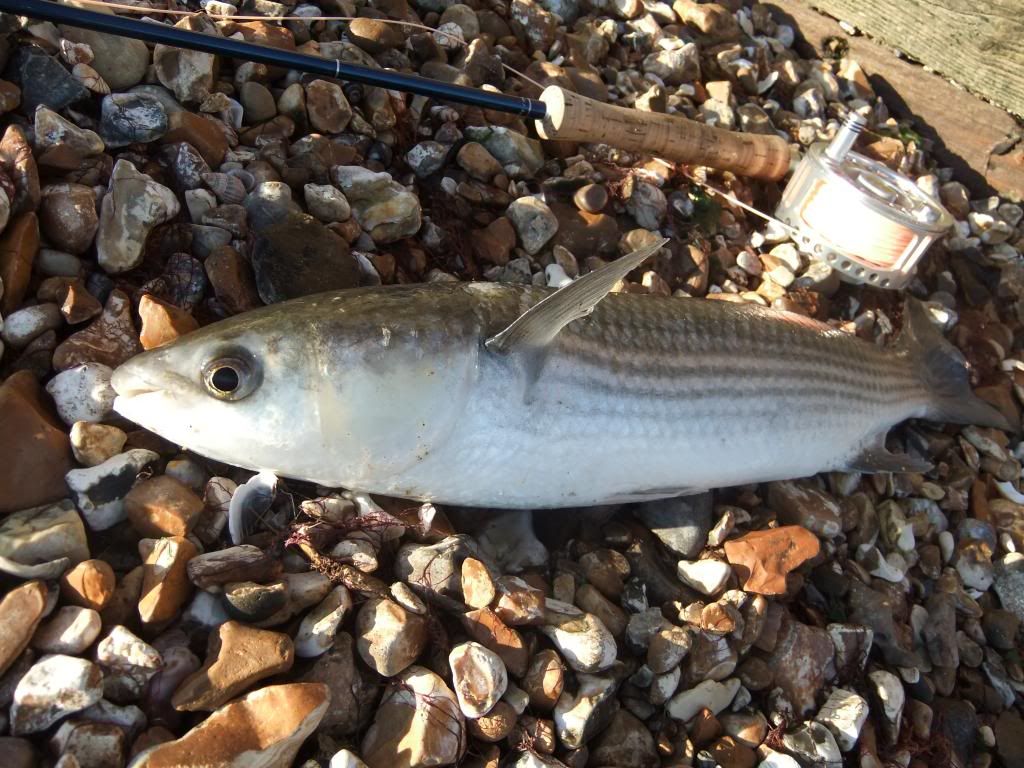
And on that happy note, the season which never really started had come to an end.

